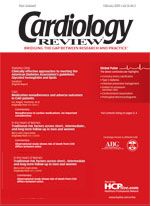Bile acid sequestrant%u2013fibrate combination effective for mixed hyperlipidemia
Lipid disorders
In patients with mixed hyperlipidemia, the addition of colesevelam HCl to fenofibrate results in further improvement in levels of low-density lipoprotein (LDL) cholesterol, non—high-density lipoprotein (HDL) cholesterol, total cholesterol, and apolipoprotein (apo) B without altering the beneficial effect of fenofibrate on triglycerides or HDL cholesterol.
The combination of colesevelam and fenofibrate offers an alternative to an HMG-CoA reductase inhibitor (statin)/fibrate or statin/niacin combination to treat mixed hyperlipidemia, according to James McKenney, PharmD, lead investigator of the study, which appears in Current Medical Research and Opinion (2005;21[9]:1403-1412).
Therapeutic targets in mixed hyperlipidemia include reducing LDL cholesterol and triglyceride levels and increasing HDL cholesterol levels. Statins are typically used as first-line therapy for the treatment of mixed hyperlipidemia because of their efficacy in reducing LDL and non-HDL cholesterol, but combination therapy is often required.
Combining a statin with a fibrate has demonstrated efficacy on several lipid parameters, but it increases the risk of myopathy and rhabdomyolysis. In one retrospective study, the rates of rhabdomyolysis requiring hospitalization were 0.44/10,000 patient-years with statin mon-otherapy and 5.98/10,000 patient-years with a statin/fibrate combination, including fenofibrate, noted Dr. McKenney, president and CEO, National Clinical Research, Inc., Richmond, Virginia.
“Mixed hyperlipidemia is a significant cause of heart disease, and a challenge for physicians to treat, especially in those patients who cannot tolerate statin therapy,” he said. “Combining a bile acid sequestrant to provide additional LDL cholesterol lowering with fenofibrate to lower triglyceride levels may provide an alternate therapy that can positively affect lipid levels. However, further studies may be necessary to show the long-term value of this combination.”
The double-blind, parallel-group study, conducted at 11 clinical sites, involved 129 patients with a mixed hyperlipidemia pattern with LDL cholesterol levels of 115 mg/dL or more and triglyceride levels of 150 or higher but less than 750 mg/dL after washout of any previous therapy. After 8 weeks of a fenofibrate run-in period, patients were randomly assigned to receive fenofibrate, 160 mg/day, plus colesevelam, 3.75 g/day, or fenofibrate plus placebo for 6 weeks.
Efficacy was recorded for the 122 patients who finished the study. Compared with patients randomized to fenofibrate plus placebo, those randomized to fenofibrate and colesevelam had a further decrease in LDL cholesterol of 12.4% (P < .001), no significant change in triglycerides, a decease in non-HDL cholesterol of 9.6% (P < .001), a nonsignificant increase in HDL cholesterol, a decline of 7.4% (P < .001) in total cholesterol, a nonsignificant increase in apo A-1, and an 8.0% reduction in apo B (P = .002).
The finding with respect to the triglyceride values was consistent in patients with triglyceride levels higher than 200
or 200 mg/dL or less at the end of the washout period.
The combination of colesevelam and fenofibrate was safe and well tolerated over the 6-week treatment period. Four patients on fenofibrate monotherapy and one on combination therapy withdrew before study completion because of adverse events. There were no clinically important differences between the treatment groups in safety laboratory parameters, vital signs, or physical findings.
